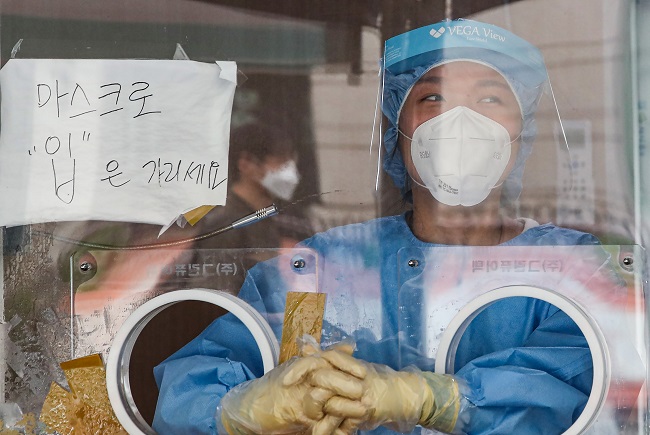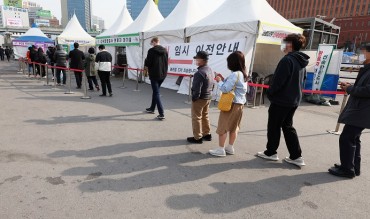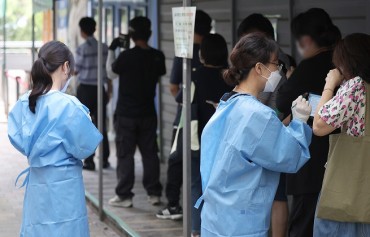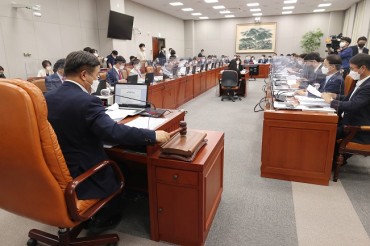
A medical worker waits to carry out COVID-19 tests at a makeshift clinic in central Seoul on Aug. 28, 2021. (Yonhap)
SEOUL, Aug. 29 (Korea Bizwire) — South Korea’s daily new coronavirus cases fell below 1,700 Sunday due to fewer tests over the weekend, but the number of patients in critical condition stayed high, sparking concerns over more fatalities down the road.
The country added 1,619 more COVID-19 cases, including 1,576 local infections, raising the total caseload to 248,568, according to the Korea Disease Control and Prevention Agency (KDCA).
Sunday’s tally compares with 1,793 on Saturday and 1,841 on Friday. Daily cases have stayed above 1,000 for 54 consecutive days. The country added 2,155 patients on Wednesday.
The number of patients normally falls over the weekend and rises later in the week as more people get tested.
The country added three more deaths from COVID-19, raising the death toll to 2,279, the KDCA said. The fatality rate was 0.92 percent.
As of 9 p.m. Sunday, 1,273 cases, including 420 from Seoul, were reported, down 201 from the same time the previous day. New infections are counted until midnight and reported the following day.
The number of patients with serious symptoms across the country reached 404, staying above 400 for a sixth consecutive day. Critical patients more than tripled from some 120 in early July, when the fourth wave began.
Health officials warned against losing vigilance toward the virus curbs, stressing that a loosening of the measures will only let infections spread further.
“It is fortunate that we have curbed the spreading trend of the fourth wave, but it is still a dangerous situation as the virus wave remains on a large scale,” Sohn Young-rae, a senior health official, said in a briefing.
“If we become careless or the quarantine measures are relaxed, we could see a sharp increase in infections again,” he said.
Sohn said that “the most pressing goal is to bring the virus wave to a clear downward trend,” saying that the authorities will work to stem the spread of the virus by taking steps to minimize loopholes, such as the inoculation of foreign workers.
With no signs of clear letup, health authorities extended the toughest distancing measures in the greater Seoul area starting last week, ordering restaurants and bars to have only take-away customers after 9 p.m., which is an hour earlier than the previous guideline.
The greater Seoul area, home to half of the nation’s 52 million population, has been under Level 4 restrictions, the highest of the four-tier virus curbs, for the past six weeks, while most other areas have implemented Level 3 distancing for the last four weeks.
The current social distancing measures are set to run through Sept. 5, and officials said they will announce revised distancing measures this Friday, including rules for the upcoming Chuseok holiday, which falls later in September this year.
During Chuseok, millions normally travel across the nation to visit family.
The country currently expects the fourth wave of the pandemic to last at least through end of next month.

Officials from the Seongbuk Ward of Seoul receive COVID-19 tests before inspecting a church on Aug. 29, 2021. (Yonhap)
South Korea also plans to speed up its inoculation program with a goal of providing at least one jab to 70 percent of the population by September to create herd immunity in November.
As of Sunday, a total of 28 million people, or 55.7 percent of the population, have received their first shots of COVID-19 vaccines, and only 14.6 million people, or 28.4 percent, have been fully vaccinated, the KDCA said.
As of Sunday, South Korea’s reserves of COVID-19 vaccines came to 10 million doses.
Of the newly confirmed domestic cases, 508 were from Seoul, 469 from the surrounding Gyeonggi Province and 91 from the western port city of Incheon, the authorities said.
The southeastern port city of Busan added 64 patients, with its neighboring South Gyeongsang Province reporting 52 infections. The southern resort island of Jeju reported 12 additional cases.
A church in northern Seoul reported 16 patients, and a construction site from Yongin, south of Seoul, found 14 infections.
Over the past two weeks, around 33 percent of the newly added patients had unknown transmission routes. Cluster infections accounted for 14 percent.
Imported cases, which include South Korean nationals, came to 43.
Arrivals from the United States accounted for seven patients, followed by Turkey with six.
The total number of people released from quarantine after making full recoveries was 218,726, up 1,737 from the previous day. This indicates nearly 88 percent of the patients reported here being fully cured.
South Korea has carried out 13,015,927 COVID-19 tests, including 32,435 from the previous day.
(Yonhap)






